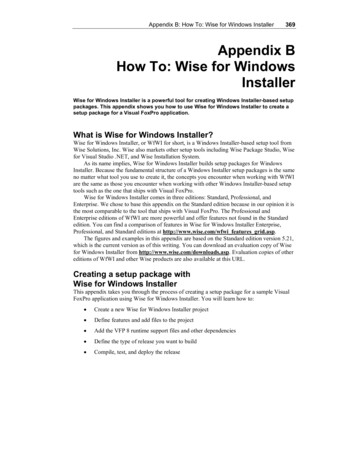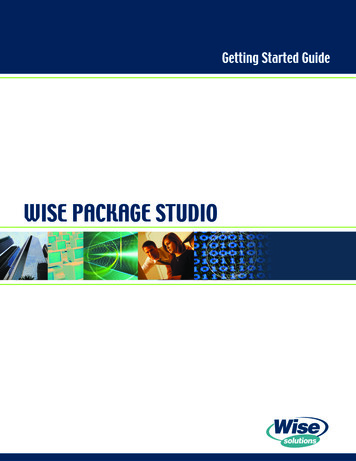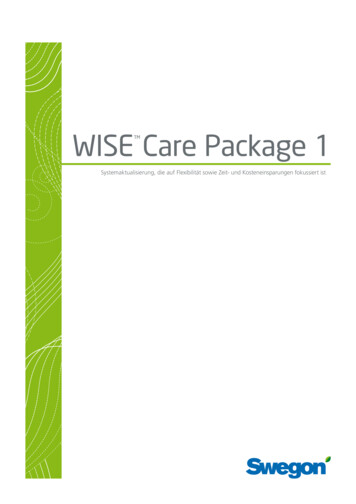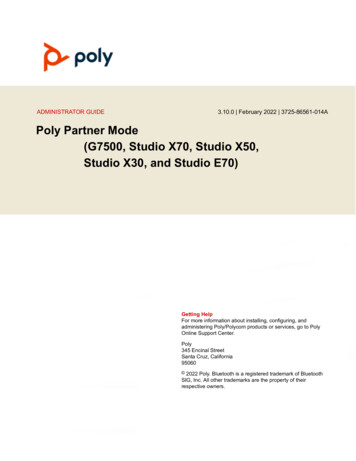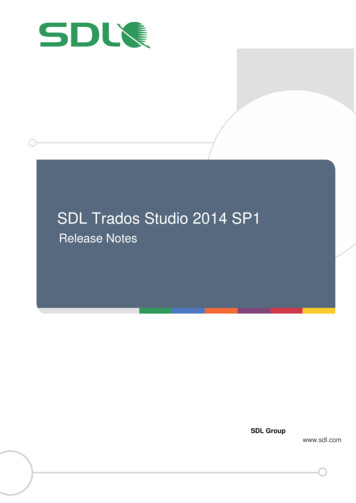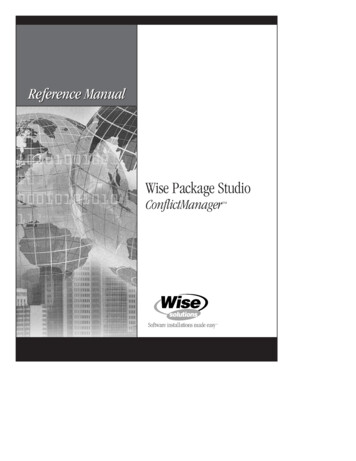
Transcription
Reference ManualWise Package StudioConflictManager
Copyright 2001 Wise Solutions, Inc. All Rights Reserved. This documentation and the accompanyingsoftware are copyrighted materials. Making unauthorized copies is prohibited by law. No part of thesoftware or documentation may be reproduced, transmitted, transcribed, stored in a retrievalsystem or translated into any human or computer language without prior written permission ofWise Solutions, Inc. Wise Solutions, Inc. asserts its “Moral Right” to be identified as the author ofthis work, in all jurisdictions that recognize the “Moral Right.”NoticeUNLESS OTHERWISE PROVIDED BY WRITTEN AGREEMENT WITH WISE SOLUTIONS, INC., THISPUBLICATION, AND THE SOFTWARE SOLD WITH THIS PUBLICATION ARE PROVIDED “AS IS”WITHOUT WARRANTY OF ANY KIND EITHER EXPRESS OR IMPLIED, INCLUDING BUT NOT LIMITEDTO THE IMPLIED WARRANTIES OF MERCHANTABILITY AND FITNESS PARTICULAR PURPOSE. THEENTIRE RISK ARISING OUT OF THE USE OR PERFORMANCE OF THIS PUBLICATION ANDSOFTWARE REMAINS WITH YOU. IN NO EVENT WILL WISE SOLUTIONS, INC., OR ANY OF ITSSUPPLIERS, BE LIABLE FOR ANY LOST PROFITS, LOST SAVINGS, DIRECT, INCIDENTAL ORINDIRECT DAMAGES OR OTHER ECONOMIC OR CONSEQUENTIAL DAMAGES, EVEN IF WISESOLUTIONS, INC., OR ITS SUPPLIERS, HAVE BEEN ADVISED OF THE POSSIBILITY OF SUCHDAMAGES. WISE SOLUTIONS, INC. RESERVES THE RIGHT TO MODIFY THIS DOCUMENT AT ANYTIME WITHOUT OBLIGATION TO NOTIFY ANYONE. IN NO EVENT SHALL WISE SOLUTIONS, INC.’SOR ITS SUPPLIERS’ LIABILITY UNDER THIS AGREEMENT EXCEED THE SUM OF ANY AMOUNTS PAIDHEREUNDER BY THE CUSTOMER TO WISE OR THE SUPPLIER.TrademarksWise Solutions, Inc. owns a number of registered and unregistered Trademarks and Service marks(the “Marks”). These Marks are extremely valuable to Wise Solutions, Inc. and shall not be used byyou, or any other person, without Wise Solutions, Inc.’s express written permission. The Marksinclude, but are not necessarily limited to the following: APPLICATIONWATCH ; CONFLICT MANAGER ;INSTALLTAILOR ; MSI DEBUGGER ; SETUPC APTURE ; SMARTPATCH ; SOFTWARE D ISTRIBUTION MADEEASY ; SOFTWARE INSTALLATIONS M ADE EASY ; U PDATEBUILDER ; WEBDEPLOY ; WISE DEBUGGER ;WISE INSTALLATION SYSTEM ; WISE MSI EDITOR ; WISE PACKAGE STUDIO ; WISESCRIPT ; WISESOLUTIONS ; WISESOLUTIONS ; WISEUPDATE ; and WISEU SER . Wise Solutions, Inc. expresslyreserves the right to use additional registered and unregistered Marks in connection with itsbusiness, and such additional registered and unregistered Marks shall be entitled to full protectionunder applicable law. Any use of any Wise Solutions, Inc. Mark shall be deemed an intentional andwillful violation of substantial rights of Wise Solutions, Inc.In addition to Wise Solutions, Inc.’s Marks, some Wise Products may include trademarks or servicemarks owned by other corporations. These other marks include, but are not necessarily limited toWINDOWS , which is a registered Trademark of Microsoft Corporation.You shall not use any of the Trademarks, or Service marks of Wise Solutions, Inc., MicrosoftCorporation, or any other entity, without the express written permission of such Trademark orService mark owner.Deletion or ModificationIf any portion of this Manual, including but not limited to the “Notice” section above, is held to beunenforceable, then that portion shall be deleted, and the remaining language shall be given itsbroadest legal effect.Wise Solutions, Inc.5880 N. Canton Center Road, Suite 450Canton, Michigan 48187 USAPhone: 734-456-2100Fax: 734-456-2456E-mail: info@wisesolutions.com Web: www.wisesolutions.com3.02
Contents1 Welcome . . . . . . . . . . . . . . . . . . . . . . . . . . . . . . . . . . . 7Documentation Roadmap .Getting Help . . . . . . . . . .Getting Product Support . .Get Support Online . . .Ask Our Support Team. .9. 10. 11. 11. 122 ConflictManager Basics . . . . . . . . . . . . . . . . . . . . . . . 13Introduction to ConflictManager. . . . . . . . . . . . . . . . . . . . . .How Do Applications and Packages Differ? . . . . . . . . . . . .What Kind of Information Does ConflictManager Compare?What Kind of Conflicts Does ConflictManager Find? . . . . . . 14. 14. 14. 15Starting ConflictManager . . . . . . . . . . . . . . . . . . . . . . .The ConflictManager Interface . . . . . . . . . . . . . . . . . . . .Areas of the ConflictManager Window . . . . . . . . . . . .Customizing Your Workspace . . . . . . . . . . . . . . . . . .Using ConflictManager in a Multi-user Environment . . . . .ConflictManager Professional and Enterprise Editions . . . .The ConflictManager Process . . . . . . . . . . . . . . . . . . . . .Before You Start to Use ConflictManager . . . . . . . . . .Process for Resolving Conflicts . . . . . . . . . . . . . . . . .Types of Conflicts. . . . . . . . . . . . . . . . . . . . . . . . . . . . .What Are Warning, Error, and Information Conflicts? .Guidelines for Resolving File Conflicts. . . . . . . . . . . . . . .When to Resolve Conflicts by Copying File InformationWhen to Resolve Conflicts by Isolating Files . . . . . . . . 16. 18. 18. 20. 21. 22. 23. 23. 24. 29. 30. 31. 33. 34.3 The ConflictManager Database . . . . . . . . . . . . . . . . . 37About ConflictManager Databases . . . . . . . . . . .Using Multiple Databases . . . . . . . . . . . . . . .Using the Sample Applications Database . . . .About the ConflictManager Share Point and IndexIndexing Files With wamdb.idx . . . . . . . . . . .QUE Files and Automatic Importing . . . . . . . . 38. 39. 39. 40. 40. 413
CONTENTSUsing the Network Index Properties DialogAdding Server Paths . . . . . . . . . . . . .Deleting a Server Path . . . . . . . . . . .Restructuring the Index . . . . . . . . . . .Rebuilding the Index . . . . . . . . . . . . .Box .Working With ConflictManager Databases . . . .Opening a ConflictManager Database . . . .Creating a New ConflictManager Database .Copying Data Between Databases. . . . . . .Compressing an Access Database . . . . . . .Deleting an Application From the DatabaseDeleting the Contents of a Database . . . . . 42. 42. 44. 45. 46. 47. 47. 48. 49. 50. 51. 524 Setting Up ConflictManager . . . . . . . . . . . . . . . . . . . . 55Defining Conflict Settings . . . . . . .Defining Conflict Types . . . . . .Excluding Files and Directories .Excluding Registry Keys. . . . . .Using Conflict Resolution Rules . . .About Conflict Resolution RulesAbout the Predefined Rule SetsCreating a New Rule Set . . . . .Editing a Rule Set . . . . . . . . . . 56. 56. 59. 62. 64. 64. 65. 66. 705 Importing and Grouping Applications . . . . . . . . . . . . 71Importing Applications Into the Database . . . . . . . .Importing From the ConflictManager Share PointImporting From a Network or Local Drive . . . . .Grouping Applications. . . . . . . . . . . . . . . . . . . . . .Creating and Editing Application Groups . . . . . . 72. 73. 78. 80. 806 Finding and Resolving Conflicts . . . . . . . . . . . . . . . . . 83Detecting Conflicts . . . . . . . . . . . . . . . . . . . . . . . . . . . . . . . .Reviewing Conflicts . . . . . . . . . . . . . . . . . . . . . . . . . . . . . . .Retrieving Conflicts in the Conflict List. . . . . . . . . . . . . . . .Clearing the Conflict Display. . . . . . . . . . . . . . . . . . . . . . .Retrieving Conflicts for a Group . . . . . . . . . . . . . . . . . . . .Viewing Properties . . . . . . . . . . . . . . . . . . . . . . . . . . . . .Resolving Conflicts . . . . . . . . . . . . . . . . . . . . . . . . . . . . . . . .Resolving File Conflicts Automatically With Rules . . . . . . . .Resolving File Conflicts Individually With the Resolve WizardResolving Registry Key Conflicts . . . . . . . . . . . . . . . . . . . .4. 84. 86. 86. 88. 88. 89. 91. 91. 92. 97
CONTENTSExporting Applications After Resolving Conflicts . . . . . . . . . . . . . . . . . . . . . 100Exporting an Application . . . . . . . . . . . . . . . . . . . . . . . . . . . . . . . . . . 101Exporting and Recompiling Applications. . . . . . . . . . . . . . . . . . . . . . . . 1037 Running Conflict Reports . . . . . . . . . . . . . . . . . . . . . 105What Reports Are Available? . . .File Information Report . . . .File Conflict Reports . . . . . .Registry Conflicts ApplicationInterpreting the Conflict Level . .Report . 106. 106. 107. 108. 110Using the Report Viewer . . . . . . . . . . . . . . . . . .Navigating Through Reports on the Screen . .Printing a Report . . . . . . . . . . . . . . . . . . . .Exporting a Report . . . . . . . . . . . . . . . . . . .Copying and Searching for Data in the Report. 112. 112. 113. 113. 114Index . . . . . . . . . . . . . . . . . . . . . . . . . . . . . . . . . . . . 1175
CONTENTS6
Chapter 1WelcomeWise Solutions’ unique ConflictManager quickly and proactively identifiesand resolves potential conflicts between Windows-based softwareapplications. ConflictManager is a database application that importsinstallation packages and then finds and resolves conflicts caused by files,registry keys, and other resources. You use ConflictManager to resolvepotential conflicts before deploying applications across your organization’sworkstations, which can reduce post-rollout costs and decrease end userdowntime.Conflicts between applications are one of the most time-consuming andcostly issues in today’s Windows workstation environment. Applicationsthat run independently without incident often fail when installed togetherdue to file and other conflicts. Conflicts can occur for many reasons, butthey most commonly occur when two installed applications use a .DLL withthe same name. For example, Package A installs version 1.0.0.4 of a filenamed report.dll. Package B installs a newer version of the same file,version 2.0.0.1. When the two packages are installed on the samecomputer, Package A might have a conflict with the newer version ofreport.dll that is installed by Package B. This conflict could cause a GeneralProtection Fault, a hung application, or some other type of problem. Thistype of conflict is commonly called “DLL Hell.”ConflictManager helps you avoid DLL Hell and other application conflicts. Itdetects conflicts that would be virtually impossible to find efficiently usingany other method and helps you achieve conflict-free workstationsthroughout your organization.Major features of ConflictManager include: A means to detect and view conflicts between applications. Conflict resolution rules that let you resolve conflicts automatically,saving time, reducing errors, and providing consistency in conflictresolution. With the Enterprise Edition, users can create and modify theresolution rules. A Resolve wizard that steps you through the process of resolving fileconflicts.7
1: WELCOME Reports that help you review and analyze conflicts detected byConflictManager. The ability to export and recompile resolved installations singly or in abatch.ConflictManager is available as a tool in Wise Package Studio. For moreinformation about Wise Package Studio, see the Wise Package Studio Help.In this section, learn about:8 The documentation that can help you get acquainted withConflictManager quickly. How to access online help and context-sensitive help. Technical support resources.
DOCUMENTATION ROADMAPDocumentation RoadmapThe ConflictManager Reference Manual and online help assume that youare proficient in the use of the Windows operating system. If you need helpusing the operating system, consult its user documentation.ConflictManager often provides multiple ways to accomplish a task. Forexample, to import an application, you can select Import from either theApplication menu or from the right-click menu. In some cases, you canaccomplish a task by using the main menu or the right-click menu, or bypressing a key combination. Instructions in this documentation generallyinclude only the most convenient method of accomplishing a task. If youare most comfortable with a particular method, check the right-click menuand the main menu to learn the different methods you can use.The following sources of information are available to help you learnConflictManager. Reference Manual. The reference manual is available from the Helpmenu; select Online Reference. It contains detailed technicalinformation and step-by-step instructions for performing common tasks.It is also available from Wise Solutions as a printed manual for a fee.Contact Wise Solutions Sales at 734-456-2100. Online Help. All the material in the reference manual is also availablein the online help system. To access the contents, index, and searchfunctions, select Help Topics from the Help menu. To access contextsensitive help, press the F1 key from any place in the product, and youwill see help that describes the part of the product that you are in. Getting Started Guide. The printed Getting Started Guide containssystem requirements, installation instructions, and a tutorial. You canalso access a .PDF copy of the Getting Started Guide from the Helpmenu in Wise Package Studio. Release Notes. Product release notes, in .HTM format, are available byselecting Release Notes from the Help menu. The release notesdocument covers new features, enhancements, bug fixes, and knownissues for the current version. It also contains links to release notes forother versions of the product.9
1: WELCOMEGetting HelpPress the F1 key to display a help window for the active window or dialogbox. You can get help on most windows, dialog boxes, and wizards inConflictManager. Select Help Topics from the Help menu to see all theinformation in the reference manual presented on-screen.Select other commands from the Help menu to view information on usinghelp, to view the .PDF-format reference manual, and to view resources onthe Web.If you need help and cannot find the answer in this manual or the onlinehelp, read about our technical support options in Getting Product Supporton page 11.10
GETTING PRODUCT SUPPORTGetting Product SupportWise Solutions offers many resources to help you use our products. Youcan search the product help or reference manual .PDF for answers, or youcan use one of the many support resources available to you as a WiseSolutions customer.Get Support OnlineTo help you get the most out of our products, we offer world-classprofessional services that include technical support, training, consulting,and Web-based resources. Just visit our support page atwww.wisesolutions.com/support.htm. Our support page contains avariety of resources such as a searchable Knowledgebase, Newsgroups,and technical support options, as well as a place for you to submit featureor enhancement requests.Check Our KnowledgebaseAccess the Knowledgebase by visiting www.wisesolutions.com/knowbase.asp or by clicking the Knowledgebase link on our Web site’ssupport page. The searchable Knowledgebase contains how-to procedures,answers to common support questions, and workarounds. It also containshighly technical material on a variety of subjects.Visit Our NewsgroupsVisit Wise Newsgroups by visiting newsgroups.wisesolutions.com or byclicking the Newsgroups link on our Web site’s support page. Newsgrouppostings by fellow administrators contain answers, tips, analysis, and othercomments. Contribute your own expertise to help other applicationrepackagers.Subscribe to TechInfoTechInfo is a free monthly technical newsletter that contains technical tips,product updates, and other important technical information. To subscribeto TechInfo or to read back issues, visit www.wisesolutions.com/techinfo.htm or click the TechInfo link on our Web site’s support page.11
1: WELCOMEAsk Our Support TeamIf you can’t find an answer in our online resources, Wise Solutions offersflexible options to meet your support needs. For additional details aboutour support services, visit our Web site at www.wisesolutions.com/support or talk with a technical support representative. Before you contacttechnical support, make sure you have the following information: Serial number and product version, which you can find by selectingAbout. from the Help menu. Operating system version and service pack version if applicable. A description of what you do before the problem occurs. The exact wording of any error messages you see. Your name, company name, and how to contact you. Payment information, if applicable.Standard SupportStandard Support is the perfect solution for registered Wise users whohave general technical questions about software installations or Wiseproducts. You can e-mail or fax unlimited technical questions 24 hours aday and receive a response within three business days at no charge. E-mailyour general support questions to standard@wisesolutions.com or faxthem to 734-456-2456.Quick Response SupportQuick Response Support is designed for registered Wise users who needquick answers to urgent issues. You can call our technical supportdepartment directly at 734-456-2600, Monday through Friday, 9:00 a.m.to 6:00 p.m. (ET). You will be charged a flat rate per incident for QuickResponse Support. Talk with a technical support representative aboutpurchasing support for multiple incidents at a reduced rate.Annual SupportAnnual Support provides unlimited technical support to registered Wiseusers who have paid an annual subscription fee. Purchasing AnnualSupport entitles you to receive a response to your technical questionswithin one business day. Depending on the Annual Support option youchoose, you can submit your technical questions in the following ways:12 Call technical support at 734-456-2600, Monday through Friday, 9:00a.m. to 6:00 p.m. (ET). E-mail the dedicated e-mail address you receive when you purchaseannual support. Fax 734-456-2456.
Chapter 2ConflictManager BasicsConflictManager is part of Wise Package Studio, and is available as a tool inPackage Studio’s Workbench. You use ConflictManager to find and resolveconflicts between software applications. This section contains anintroduction to ConflictManager terms and concepts. Additional topicscover: Starting ConflictManager. The ConflictManager interface. Using ConflictManager in a multi-user environment. ConflictManager Professional and Enterprise Editions. The ConflictManager process. Types of conflicts. Guidelines for resolving file conflicts.13
2: CONFLICTMANAGER BASICSIntroduction to ConflictManagerIf you are a system administrator or desktop integrator responsible for themanagement and installation of software applications on a large number ofworkstations, ConflictManager can help you do your job more efficiently.ConflictManager improves the reliability of end user desktops by reducingthe risk of problems when you deploy a new application. UsingConflictManager, you can detect and resolve potential conflicts beforeadding a new application to those already installed on users’ workstations.How Do Applications and Packages Differ?ConflictManager detects and resolves conflicts between Windows-basedsoftware applications. Applications can include third-party commercialsoftware as well as in-house custom software. All applications that areinstalled on computers in your organization should be imported intoConflictManager so you can ensure they will not conflict with one another.When you import an application into ConflictManager, you must assign it apackage name. Packages represent different versions of a singleapplication installation, or different components of a larger suite. Forinstance, the Microsoft Office application installation might contain twopackages, Office 97 and Office 2000. Another way to organize the MicrosoftOffice application would be to set up packages for Word, Excel, andPowerPoint. Because you are not likely to install two versions of anapplication on the same computer, ConflictManager does not look forconflicts between packages of the same application. This speeds theconflict detection process and avoids showing you conflicts that are notrelevant.What Kind of Information Does ConflictManagerCompare?During conflict detection, ConflictManager searches the databaseinformation listed below for each application and marks items that conflict.File nameVersionBinary versionSizeDate/timePathCompanyProduct16 bit (Yes or No)14
INTRODUCTION TO CONFLICTMANAGERComponent GUID (Windows Installer installations only)KeyPath (Windows Installer installations only)Resource count (Windows Installer installations only)Shared .DLL (Windows Installer installations only)Registry key valueThis information is displayed in the Resolve wizard, which you start byselecting Resolve from the Conflicts menu. The information is alsodisplayed in the Properties dialog box, which you open by double-clickingthe conflicting item in the right pane of the Application Explorer.What Kind of Conflicts Does ConflictManager Find?ConflictManager finds and lets you resolve conflicts caused by differentapplications that install files with the same name. To save time duringconflict detection, ConflictManager only searches for the followingsituations: Duplicate files, of any type, in the Common Files directory and anysubdirectory of Windows, including the System directory. For example, iftwo different applications both install the file readme.txt in the CommonFiles directory, ConflictManager marks them as conflicts. If you don’twant ConflictManager to find conflicting readme.txt files, you canexclude that file, or any other files you don’t care about, from theconflict detection. Duplicate executable files only (.EXE, .DLL, and .OCX files) in all otherdirectories. For example, if two applications install sslib.dll in theProgram Files directory, it is considered a conflict.In addition to file conflicts, ConflictManager also finds conflicts that occurwhen two or more applications install the same system resource, such asregistry keys, Autoexec.bat, Config.sys, ODBC, NT services, devices, .INIfiles, shortcuts, and the PATH variable. Experienced users can resolveregistry key conflicts in ConflictManager. The other types of conflicts cannotbe resolved in ConflictManager and are displayed for informationalpurposes only. For more information about conflict types, see Types ofConflicts on page 29.15
2: CONFLICTMANAGER BASICSStarting ConflictManagerConflictManager is one of the tools included in Wise Package Studio.Typically, you start ConflictManager from the Projects tab by running a toolor task that is associated with ConflictManager. You can also startConflictManager from the Tools tab by double-clicking the ConflictManagericon.To start ConflictManager:Start ConflictManager from Wise Package Studio in either of two ways: From the Projects tab, click the Run link to the right of the task or toolassociated with ConflictManager.OR From the Tools tab, double-click the ConflictManager icon.The ConflictManager program opens. You can now detect, retrieve, andresolve conflicts for the application of your choice. 16The first time you start ConflictManager, it opens the default database, ifyou specified one during installation. Typically this database is empty. Ifthis database is shared, it might contain applications imported by otherusers. If you imported sample applications during installation, theyappear in the database.
STARTING CONFLICTMANAGER The first time you start ConflictManager, if you skipped the databasesetup during installation, the Select Data Source dialog box appears andyou must connect to a database. See Opening a ConflictManagerDatabase on page 47. If one or more installations have been distributed to the ConflictManagershare point, the Import from Share Point dialog box appearsautomatically. You can select applications and click OK to import them,or click Cancel to start ConflictManager without importing applications.See Importing From the ConflictManager Share Point on page 73 formore information. If the database contains applications but conflicts have not beendetected yet, the Detect Conflicts dialog box appears automatically. Youcan select applications and click OK to detect conflicts, or click Cancel tostart ConflictManager without detecting conflicts. See DetectingConflicts on page 84 for more information.If you’re new to ConflictManager, you might want to open the sampleapplications database and experiment with finding and resolving conflicts.See Using the Sample Applications Database on page 39.17
2: CONFLICTMANAGER BASICSThe ConflictManager InterfaceWhen you start ConflictManager, you see the main ConflictManagerwindow. Some of the panes might be empty if you have not imported anyapplications or detected conflicts. Importing applications populates thedatabase with information about the applications. Detecting conflicts findsconflicts between one or more selected applications and all otherapplications in the database. Retrieving conflicts displays the conflicts foran application you choose.Conflict List.Choose theapplication andpackage for whichyou want to displayconflicts, then clickRetrieve.When you retrieveconflicts, this pane ofthe Conflict Listdisplays all the conflictsbetween the selectedapplication and the restof the database.Double-click an item tosee the items thatconflict with it.ApplicationExplorer. Showsthe installationsthat you’veimported into thedatabase.Groups. This paneshows the groupsyou’ve defined. Select agroup to show conflictsbetween the selectedapplication and thesubset of applicationsthat’s defined by agroup. EnterpriseEdition only.The right pane ofthe ApplicationExplorer shows thecontents of thefolder selected inthe left pane.Status Bar. Shows the conflict detectionstatus. “Idle” displays when conflict detectionis not running.Areas of the ConflictManager WindowConflict List. This pane initially appears at the top of the window, and letsyou view conflicts between an application and the rest of the database. Youchoose an application and package, and other filtering criteria, and clickRetrieve. The right pane of the Conflict List shows all conflicts between theselected application and all other applications in the database. When youclick a conflict item in this pane, the tree structure in the ApplicationExplorer automatically expands to show the location of the conflict. In theEnterprise Edition, if a group is selected, only the conflicts between theselected application and the applications in the group appear.Conflicts are classified as either warnings, errors, or information. See WhatAre Warning, Error, and Information Conflicts? on page 30 for descriptionsof these conflict classifications.18
THE CONFLICTMANAGER INTERFACEApplication Explorer. The Application Explorer initially appears in thelower left of the window. The left pane of the Application Explorer shows allapplications that are in the current ConflictManager database. You can seeall the file, registry, and .INI modifications made by each installation byexpanding the tree structure beneath its name. The three icons in thispane are:Group Icon. In the Enterprise Edition, this icon represents the groupthat you are currently viewing. “All Applications” is considered a group(it is the only group in the Professional Edition). You choose a group inthe Groups pane, which you open by selecting Groups from the Viewmenu.Application Icon. This icon represents an application installation thatis in the ConflictManager database.Package Icon. This icon represents the different versions of a singleapplication installation. For instance, the Microsoft Office applicationinstallation might contain two packages, Office 97 and Office 2000.Packages are differentiated in the database so ConflictManager canavoid showing conflicts between different packages of the sameapplication.The right pane of the Application Explorer contains the conflicts that arelocated in the folder that’s selected on the left. This lets you see conflictsby location in the installation.Groups. The Groups pane, accessed by selecting Groups from the Viewmenu, initially appears in the lower right of the window, and shows groupsyou defined. You use groups to see conflicts between a given subset ofapplications. Normally, when you click the Retrieve button, the selectedapplication is compared against every other application in the database. Ifyou only want to see conflicts within a particular group of applications, youcan create a group of applications and display conflicts only within thatgroup.Enterprise Edition onlyGroups are available in the Enterprise Edition only.19
2: CONFLICTMANAGER BASICSCustomizing Your WorkspaceTo customize the ConflictManager window, you can show or hide its panes,resize the panes, and dock and undock the Groups
Wise Solutions, Inc. Wise Solutions, Inc. asserts its "Moral Right" to be identified as the author of this work, in all jurisdictions that recognize the "Moral Right." Notice UNLESS OTHERWISE PROVIDED BY WRITTEN AGREEMENT WITH WISE SOLUTIONS, INC., THIS PUBLICATION, AND THE SOFTWARE SOLD WITH THIS PUBLICATION ARE PROVIDED "AS IS"

